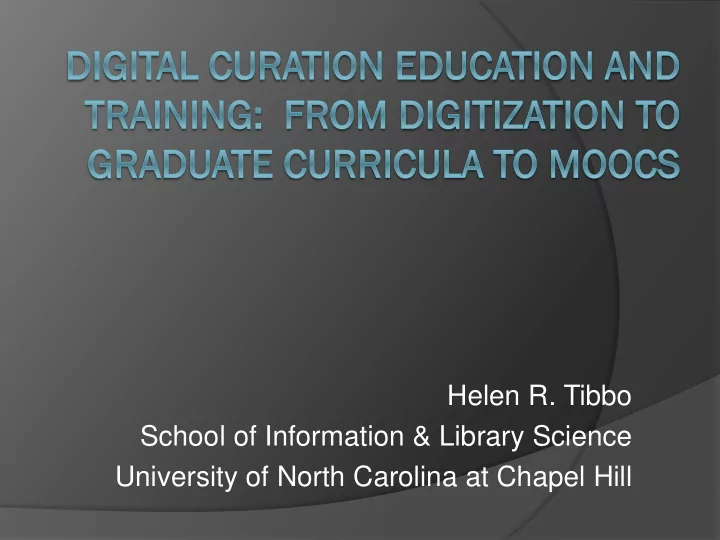

Helen R. Tibbo School of Information & Library Science University of North Carolina at Chapel Hill
Thank You Institute of Museum and Library Services (IMLS) School of Information & Library Science DCC, and especially Bridget Robinson You, the Audience!
Today’s Talk Development of digital and data curation curricula Focus on North America Focus on continuing/professional/ vocational education Looks at a wide variety of formats and delivery systems from face-to-face courses to webinars to MOOCs Discusses pedagogical issues Thoughts on what is needed for workforce training for digital stewards.
Where We Are Curation of digital assets is one of the central challenges of the early 21st century. The last decade has witnessed extensive progress toward robust repository architectures and cyberinfrastructure, preservation tools, strategies, and standards, and trustworthy and sustainable repositories.
Recognition of Need IMLS started Digital Curation funding stream in Laura Bush grants in 2005. “ one of the major challenges of this scientific generation [is] how to develop the new methods, management structures and technologies to manage the diversity, size, and complexity of current and future data sets and data streams..” (NSF 2007)
DataNet and Need for Digital Curators Led NSF to call for “developing a coherent data cyberinfrastructure in a complex global context” and a “national digital data framework” NSF, March 2007 This resulted in the Sustainable Digital Data Preservation and Access Networked Partners (DataNet) call for proposals and funded projects. Such a vision requires a cadre of DC professionals to work in libraries, archives, museums, data centers, and an increasing array of data-intensive organizations.
Early Offerings in Digitization and Management of Digital Content 1995: Northeast Document Conservation Center (NEDCC) conducted its first “School for Scanning: A Conference on Digitization, Microfilm, and Preservation,” at the JFK Library in Boston, MA. NEDCC. 1996: Anne Kenny of Cornell University Libraries led “Digital Imaging for Libraries and Archives” the first in a series of programs that would set the standard for early digitization workshops and lead to today’s Digital Preservation Management (DPM) workshop series.
Early Offerings in Digitization and Management of Digital Content 1998: the Humanities Advanced Information Institute (HATII) at the University of Glasgow under the direction of Seamus Ross started a Summer School on Digitization for Cultural Heritage Professionals. This ran in the UK, US, and various other locations through mid-2000s.
Scanning Workshops Led to Digital Curation Education While the focus in these workshops was on best scanning practice, the courses were imbued with content on project management and technical standards. The lifecycle of content was discussed and users were factored into the scenarios. These programs were the start on what has developed into graduate and post- master’s certificates, workshops of varying lengths and a wide range of foci, and most recently, MOOCs (Massively Open Online Courses) in data curation and management.
Today’s Reality Existing education programs remain insufficient for the training needs of the information and data management professions let alone data creators, information technology staff, and other stakeholders in the digital curation lifecycle. In 2010 OCLC found, the “‘most challenging issues’ in managing special collections were space …, born - digital materials, and digitization .”
Aud udience ience One-size-fits-all approach does not work. Heterogeneity is difficult. Fundamental principles need to be taught. Hands-on computing exercises need to be included. Sector market surveys needed to determine profession-wide needs.
What to Teach What should the content be? General and broad Specific Introductory Advanced Audience up-take Sequencing Lectures, exercises, breaks, scenarios
How Long to Teach How long? Don’t over cram Instructional goals What will the audience pay? How long will people attend?
What at Edu duca cational tional Moda dality? lity? Face-to-face Classroom Lab Webinars Participants may be at their desks working MOOCs or Massively Open Online Courses May be at set times May be available on demand
Sustainability Lots of education based on grant projects. No ongoing certification required for librarians and archivists in US Hard for university programs to run continuing education programs Not their primary mandate Courses may go half filled and thus are not self-supporting or revenue-generating
Promising Developments ISO 16363: Audit and Certification of Trustworthy Digital Repositories may lead to more professionals wanting continuing education Society of American Archivists (SAA) is having success with its Digital Archives Specialist (DAS) Certificate program
Business Models Needed Business model needed to work out sustainability Other questions: How is the academic going to be rewarded for working in this arena beyond formal graduate and undergraduate education? How can we reach such a large audience (everyone needs to know about digital curation!)? Can I-Schools provide the digital curation teaching capacity that the government, military, corporate, scientific, academic, and public sectors will require?
Professional Workshops – Other Issues Who should do the instruction? What training do instructors need? What is the best sequencing of brief workshops? Should courses have pre-requisites? How can the instructor best meet the needs of a diverse class? How much should courses cost? How can educators encourage institutions to support their employees in taking continuing education?
Conclusions Education for digital curation is very different today than it was 10 years ago when the IDCC made its debut. Graduate-level programs are springing up although no one curricular model is as of yet dominant. Educators should not forget their alumni working in the information curatorial professions. Employing institutions also need to support their current staff in their educational efforts and mandate ongoing continuing education.
Conclusions Funders such as IMLS, the EC, and JISC have been instrumental in developing digital and data curation programs within today’s iSchools. Funders need to focus on continuing education as well. Libraries, archives, and museums will never ride the crest of the digital wave if they must wait for new employees to bring knowledge of new technologies. Certification of practitioners, while unlikely, would be a great help in creating professional education programs. The situation is crying out for partnerships between educators and practitioners.
Come visit us in Chapel Hill for iPRES 2015! November 2-6 ipres2015.org
Thank you! Questions?
Recommend
More recommend